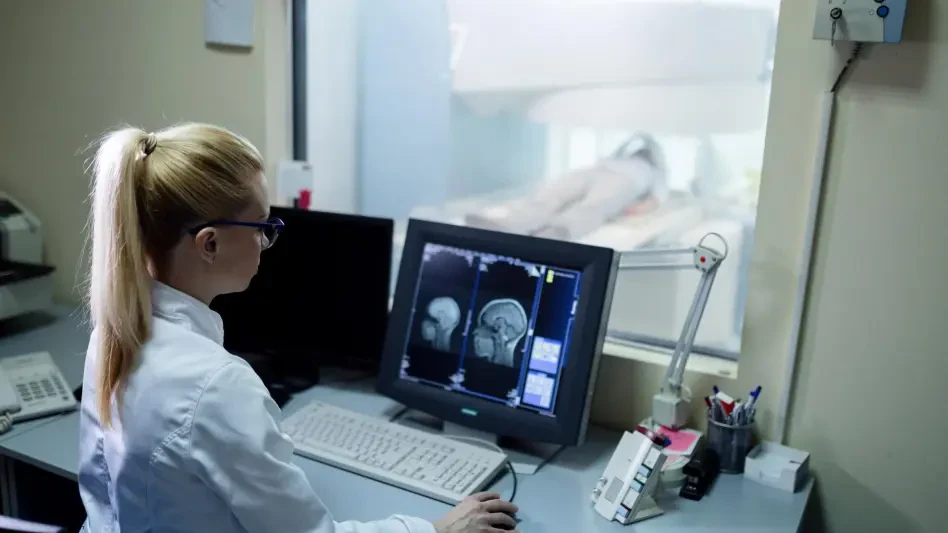Radiologists kept asking for workstation power without the workstation, and a browser finally answered at scale with speed, fidelity, and reporting that hold up under real clinical pressure. The arrival of Philips Image Management 15 marks a decisive break from the thick-client era, bringing a zero-footprint diagnostic viewer that runs in a standard browser yet claims the horsepower of a desktop. The promise is simple but bold: remove local installs, move heavy lifting to the server, and keep the experience consistent whether reading from a hospital workstation or a laptop at home.
The stakes are high. Imaging volumes keep climbing while staffing remains tight, and every pause between viewing and reporting stretches turn-around time. By fusing server-side rendering with interactive reporting and tight hooks into AI and advanced visualization, this release aims to compress the journey from pixels to final report. The result, if it holds, is a platform designed to push reading speed and collaboration forward without multiplying IT overhead.
From thick clients to zero-footprint
Philips built Image Management 15 as the spiritual successor to Vue PACS, but it doesn’t just wrap the old model in a new skin. It reorients the diagnostic session around the browser and the data center, with server-side rendering translating complex modalities into responsive streams. That architecture reduces the importance of local hardware while centralizing performance and updates in one place.
This shift lines up with broader moves in health IT: cloud-first operations, SaaS economics, and AI woven into everyday work. It also sets a clear target—deliver workstation-grade tools and quality without asking radiologists or IT to babysit endpoints. The viewer stakes credibility on the claim that zero-footprint no longer means light-duty.
Core capabilities and architecture
Zero-footprint diagnostics
Function and design
The viewer brings full diagnostic tooling—hanging protocols, MPR, measurements, advanced layout—straight into a modern browser. There is no local install, which trims rollout time and sidesteps version drift, while giving authorized users the same capabilities on managed desktops or personal devices.
Performance characteristics
Despite running in the browser, the experience aims for desktop-grade responsiveness and stable image quality. Rendering precision and tool latency are designed to remain steady across a wide range of studies, not just small series, so high-stakes reads are not handicapped by the delivery channel.
Significance in workflow
The immediate gain is operational: IT teams can harden a single platform and push it enterprise-wide. The deeper win is behavioral—radiologists log in and work, without juggling apps, drivers, or GPU compatibility.
Server-side rendering and streaming
Processing model
Heavy computation moves to the server tier, where controlled hardware handles complex modalities and advanced visualization. Client browsers receive streamed results, which offloads noise introduced by varied endpoint configurations.
Performance and responsiveness
For digital breast tomosynthesis, cardiac CT, and other data-heavy exams, server-side rendering maintains a consistent feel even when networks fluctuate. Pre-fetching and adaptive streaming keep interaction smooth, so scrolling and cine remain predictable.
Impact on remote reading
Because compute sits centrally, remote users experience the same engine as on-site staff. That consistency reduces friction for after-hours coverage, cross-campus pools, and load-balanced reading.
Cloud-first and hybrid deployment
HealthSuite on AWS (SaaS)
The cloud option runs on Philips HealthSuite on AWS as a managed service, offering elastic scaling, centralized updates, and unified observability. The model emphasizes predictable operations with security controls native to the platform.
On-premises option
Some organizations prefer to step into cloud change more slowly. The on-premises route supports that path, preserving existing investments while adopting the viewer’s zero-footprint delivery and server-side rendering.
Scalability and multi-site readiness
Elastic resources expand during peak demand and contract afterward, which suits enterprise growth and seasonal surges. Multi-site orchestration becomes simpler when performance lives in the data center rather than at the desktop.
Integrated reporting in the viewer
In-viewer reporting
Reading and reporting sit in one place, so there is no pivot to a separate dictation or reporting app. That alignment reduces context switching and keeps the cognitive thread intact from first frame to final impression.
Structured and interactive elements
Findings, key images, and annotations can synchronize with report sections, tying narrative to evidence. This linkage minimizes manual steps and helps ensure that structured content reflects what appeared on screen.
Workflow outcomes
The result is shorter time-to-diagnosis and more consistent documentation. Over time, those minutes add up across a department, easing pressure without adding headcount.
AI and advanced visualization
Connected AI tools
The platform connects to AI services that surface relevant priors, suggest anatomy-specific insights, and flag urgent patterns. The intent is to reduce mental overhead, not to replace clinical judgment.
Advanced Visualization Workspace tie-in
When deeper analysis is needed, results from Advanced Visualization Workspace can feed directly into the report. That pathway minimizes copy-paste churn and keeps advanced findings traceable.
Status and availability
Some AI functions remain works in progress, with timelines subject to change. Sites should validate which modules are cleared and supported for their region and use case.
Mobility, collaboration, and scale
Cross-facility workflows
A harmonized interface follows radiologists across devices and sites, which matters for health systems with shared reading pools. Users move between hospitals or home setups without relearning tools.
Collaboration features
Shared presentation states and synchronized views make case discussions straightforward. Tumor boards and teaching sessions benefit from consistent displays across participants.
Operational benefits
Distributed teams can stretch coverage without sacrificing quality. The platform’s reach supports after-hours reading and cross-border collaboration where regulations allow.
Security, compliance, and governance
Built-in security posture
Cloud-native access controls, audit trails, and centralized policy management form the default stance. Administrators can set boundaries once and apply them broadly.
Compliance considerations
High-level claims are promising, but certifications and site-specific controls still need confirmation. Hospitals will expect explicit frameworks, including HIPAA alignment and third-party attestations.
Data residency and access
Deployment options allow for regional data placement, with access controls tailored to local rules. Consent models and retention policies can be tuned to organizational governance.
Performance, reliability, and signals from users
Vendor claims and early feedback
Philips cites strong speed and an intuitive interface, echoed by an early adopter in Europe. That endorsement signals momentum but does not substitute for broad validation.
Reliability targets
The architecture emphasizes uptime and stable streaming, aiming to keep read sessions uninterrupted. Monitoring and rollback paths matter as much as raw speed for clinical trust.
Evidence gaps
Independent benchmarking across modalities and networks remains limited. Comparative studies against leading web viewers would clarify real-world standing.
What is moving the market
Cloud modernization and AI-native workflows are reshaping imaging informatics, and this release plugs into both. The browser becomes the operating surface for diagnostics, while the data center and cloud shoulder computation and orchestration. Interoperability across enterprises turns from aspiration to requirement as systems aim to read anywhere without losing fidelity.
At the recent RSNA, Philips highlighted generative AI that automates display protocols and builds concise patient context, along with agentic AI that prioritizes and orchestrates anatomy-aware tasks. Those ideas point toward quieter, smarter sessions where routine steps fade into the background and radiologists stay focused on decisions.
Competition is heating up among web viewers, but Philips leans on unified reporting and deep AV integration as differentiators. The gaps are clear as well: certifications, regional approvals, and broad, third-party performance data. Due diligence now hinges on pilots and proof-of-value, not slideware.
Where it fits in the real world
Academic centers will test the limits first, throwing large, complex datasets at the viewer and staging multi-reader sessions. Browser access simplifies teaching conferences and joint reviews, while server-side rendering keeps advanced cases responsive.
Community hospitals and integrated delivery networks stand to gain from standardized workflows across sites. Centralized administration trims endpoint support, and consistent performance means radiologists can float across facilities without friction.
Teleradiology is another bright spot. With compute centralized and streaming tuned for variable networks, remote reads feel closer to on-site work. During surges, elastic scaling can add capacity fast, supporting continuity without new hardware.
For cross-border work, harmonized presentation states help align reads across modalities and time points. Data access still hinges on residency, consent, and regulatory frameworks, which makes deployment design as critical as feature selection.
AI-assisted protocoling and reporting show early promise. Nudges inside the reading pane keep context close, while AV outputs feed the final report without manual stitching. The value comes from shaving seconds on every case, every day.
Risks, gaps, and mitigation
Network variability still shapes the user experience, even with adaptive streaming. Sites should assess bandwidth and latency patterns and stage pilots across real-world conditions before scaling up.
Complex modality edge cases demand careful validation to ensure fidelity. Departments should build test decks for DBT, cardiac CT, and longitudinal comparisons, then verify measurement consistency and display neutrality.
Security and compliance specifics remain a procurement gate. Clear evidence—SOC 2, HIPAA-aligned controls, regional clearances—will be required, along with role-based access, logging, and retention policies that map to governance.
Change management cannot be an afterthought. Training radiologists to trust a browser viewer and consolidating RIS, EMR, and PACS integrations take planning. Establishing success metrics—time-to-report, accuracy, reader satisfaction—helps keep adoption honest and measurable.
Verdict
Image Management 15 delivered a convincing case that a browser could handle full-bore diagnostic work while chopping deployment friction and centralizing performance. It combined zero-footprint access, server-side rendering, and an integrated reporting stack into a coherent daily experience, then layered growing AI ties and AV integration on top. The remaining work sat in validation and proofs: independent benchmarks, explicit certifications, and regional clearances. For buyers, the next steps were clear—run pilots that mirror peak workflows, verify modality fidelity, stress-test networks, and lock governance—and the platforms that passed those trials earned a credible path toward systemwide rollouts.









